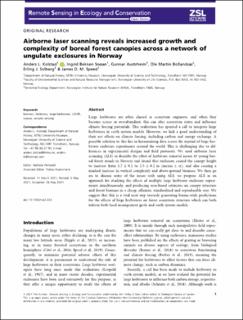| dc.contributor.author | Kolstad, Anders Lorentzen | |
| dc.contributor.author | Snøan, Ingrid Bekken | |
| dc.contributor.author | Austrheim, Gunnar | |
| dc.contributor.author | Bollandsås, Ole Martin | |
| dc.contributor.author | Solberg, Erling Johan | |
| dc.contributor.author | Speed, James David Mervyn | |
| dc.date.accessioned | 2022-02-11T13:09:18Z | |
| dc.date.available | 2022-02-11T13:09:18Z | |
| dc.date.created | 2021-06-09T15:25:54Z | |
| dc.date.issued | 2021 | |
| dc.identifier.citation | Remote Sensing in Ecology and Conservation. 2021, . | en_US |
| dc.identifier.issn | 2056-3485 | |
| dc.identifier.uri | https://hdl.handle.net/11250/2978500 | |
| dc.description.abstract | Large herbivores are often classed as ecosystem engineers, and when they become scarce or overabundant, this can alter ecosystem states and influence climate forcing potentials. This realization has spurred a call to integrate large herbivores in earth system models. However, we lack a good understanding of their net effects on climate forcing, including carbon and energy exchange. A possible solution to this lies in harmonizing data across the myriad of large herbivore exclosure experiments around the world. This is challenging due to differences in experimental designs and field protocols. We used airborne laser scanning (ALS) to describe the effect of herbivore removal across 43 young boreal forest stands in Norway and found that exclusion caused the canopy height to increase from 1.7 0.2 to 2.5 0.2 m (means SE), and also causing a marked increase in vertical complexity and above-ground biomass. We then go on to discuss some of the issues with using ALS; we propose ALS as an approach for studying the effects of multiple large herbivore exclosure experiments simultaneously, and producing area-based estimates on canopy structure and forest biomass in a cheap, efficient, standardized and reproducible way. We suggest that this is a vital next step towards generating biome-wide predictions for the effects of large herbivores on forest ecosystem structure which can both inform both local management goals and earth system models biomass, herbivory, large herbivores, LiDAR, moose, remote sensing | en_US |
| dc.language.iso | eng | en_US |
| dc.publisher | Wiley | en_US |
| dc.rights | Attribution-NonCommercial-NoDerivatives 4.0 Internasjonal | * |
| dc.rights.uri | http://creativecommons.org/licenses/by-nc-nd/4.0/deed.no | * |
| dc.title | Airborne laser scanning reveals increased growth and complexity of boreal forest canopies across a network of ungulate exclosures in Norway | en_US |
| dc.type | Peer reviewed | en_US |
| dc.type | Journal article | en_US |
| dc.description.version | publishedVersion | en_US |
| dc.subject.nsi | VDP::Zoologiske og botaniske fag: 480 | en_US |
| dc.subject.nsi | VDP::Zoology and botany: 480 | en_US |
| dc.source.pagenumber | 13 | en_US |
| dc.source.journal | Remote Sensing in Ecology and Conservation | en_US |
| dc.identifier.doi | 10.1002/rse2.224 | |
| dc.identifier.cristin | 1914888 | |
| dc.relation.project | Norges forskningsråd: 184036 | en_US |
| dc.relation.project | Norges forskningsråd: 262064 | en_US |
| cristin.ispublished | true | |
| cristin.fulltext | original | |
| cristin.qualitycode | 1 | |

